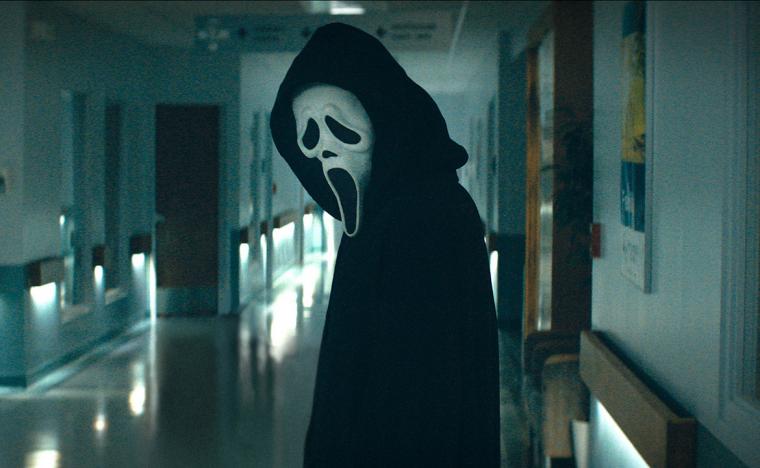
????? in Scream
SCREAM
“Who goes to a party during a killing spree?” This is a question asked by one of the elder characters – by which I mean someone in his early 20s – in directors Matt Bettinelli-Olpin's and Tyler Gillett's Scream, the fifth installment in this apparently unkillable horror-comedy franchise. It's a query clearly posed by a genre novice. Who goes to a party during a killing spree? Dopey-ass teens in a slasher flick, that's who. You know this. I know this. The filmmakers certainly know this. Yet as the adage goes: “A little knowledge is a dangerous thing.” And while this latest, incessantly meta sequel is frequently clever and easily watchable, it also kept reminding me, unfortunately, that there's a fine line between smart and smarty-pants.
As with every Scream dating back to 1996, the prelude is the film's scariest and most well-sustained sequence. I'm sure you remember the drill. (Bettinelli-Olpin, Gillet, and screenwriters James Vanderbilt and Guy Busick are no doubt hoping you do.) It's nighttime in sleepy Woodsboro, California, and a high schooler (Jenna Ortega's Tara) is home alone. She gets a call from an insidiously voiced stranger who wants to play a game of horror-movie trivia, threatening Tara with death – and, in this case, the death of her best friend – if she refuses, calls the police, or fails the quiz. Terrorized, hyperventilating Tara does reasonably well, but trips up on the final trick question, leading to the arrival of Ghostface, the series' resident knife wielder and ambulatory Munch painting. Blades are drawn. Flesh is ripped. Shrieks are heard. Cue the title card.
Because Scream 4 landed more than a decade ago (!), I found the familiarity of this opening scene, despite its intensity and viscera, kind of endearing – as if Woodsboro were a blood-soaked Brigadoon where nothing much changed in the quarter-century since Wes Craven made his comeback and Kevin Williamson began writing every teen entertainment in existence. But I was also jazzed by the movie's early wit. Given that Ghostface's initial call comes from an unknown number on her folks' land line, Tara does what anyone would do: She ignores it. (Naturally, she's not allowed to for long.) When Ghostface tells the girl he's going to ask questions about the Stab series, that franchise-within-the-franchise based on the “real life” Scream events, Tara begs to instead be quizzed on It Follows or Hereditary or The Witch – examples of the “elevated horror” she prefers over the slice-and-dice of the Stab (and Scream) efforts. When Tara is stumped by Stab trivia, she stalls Ghostface on the land line while Googling the correct answers on her iPhone. And in perhaps the sequence's savviest touch – one that we won't realize for another few minutes – the black-clad psycho's attack on Tara inevitably comes to pass … but the victim survives. The Scream-savvy among you will recognize this as a series first. The really Scream-savvy among you will recognize this as a reason to suspect Tara herself of being one of the killers.
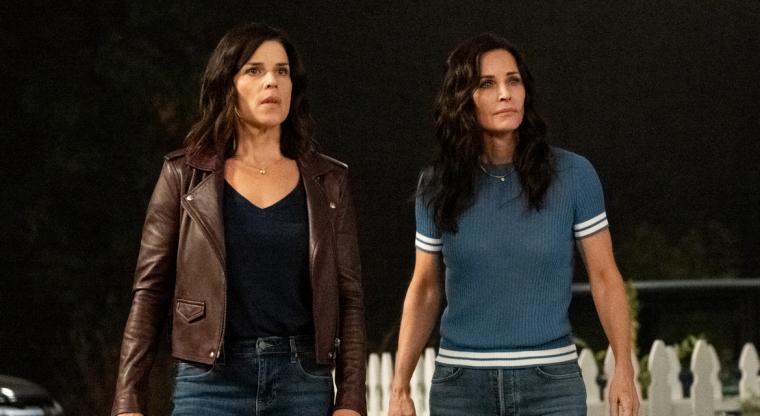
After all, as we're reminded, there are always two killers in these things, just as we're reminded that we should always be leery of those with familial ties to previous murderers and always instinctively distrust the boyfriend. These are nuggets of wisdom provided by the returning, nine-times-stabbed Dewey Riley, whose portrayer David Arquette makes a welcome return alongside fellow series stalwarts Neve Campbell as Sidney Prescott and Courteney Cox as Gale Weathers. There's also another bunch of sardonic teens, a few cameos from former Scream castmates (nice to see you, Heather Matarazzo!), and a victimized lead (Melissa Barrera's Samantha) whose visions of a weirdly de-aged Skeet Ulrich place her high on the list of suspects. But for all of these disparate personalities, there's really only one topic of conversation: Determining what's going to happen this time based on what happened last time. That, in turn, makes every talking point a meta-commentary: on the Scream films; on the Stab films; on the genre imperatives of the Scream and Stab films. And that, in the end, proves exhausting, because while a number of them are admittedly inventive, there are so many echoes to the past here that the movie barely exists in the present.
This wheel-spinning, snake-eating-its-tail quality is especially distracting in one sequence featuring Dylan Minnette, who's been cast as a high schooler at least since 2013's Prisoners. (I kept waiting for the movie's poking of clichés to include a jab at teen roles eternally played by actors in their mid-20s.) The scene finds Minnette's Wes alone in his house while repeatedly opening doors and cabinets: a strict horror-flick no-no, as the instant that a door or cabinet is closed is routinely the instant in which the lunatic suddenly appears from behind it. But with every opening and subsequent pause, Bettinelli-Olpin and Gillet ramp up the scary music to make us expect the worst, only to reveal … nothing. As genre in-jokes go, it isn't a bad one. Focusing on this oft-repeated trickery for the sake of a few laughs, though, pulls us out of Wes' potentially perilous experience – it does nothing but inspire memories of other movies – and there's a similar effect whenever characters wander to the basement alone or show up with shaky alibis or, God forbid, say “I'll be right back.” Each of the Scream sequels relies on this sort of elbow-in-the-ribs audience baiting, letting us know that the filmmakers know that we know how these movies work. Yet until now, such callbacks have never seemed like the film's entire point, and if Scream 5.0 isn't toying with our memories or slasher-slick awareness, it isn't really doing much of anything.
Consequently, Bettinelli-Olpin's and Gillett's offering was never as funny as I wanted it to be and definitely wasn't as frightening as I wanted it to be – but the movie did have its charms. The time-warp cinematography (by Brett Jutkiewicz) provided an appropriately over-bright '90s warmth, and while I, too, am a little concerned about whatever's going on with Courteney Cox's face these days, it was sweet to see her reunited with Arquette as both her fictional and real-world ex. Campbell's gravitas and natural empathy made me wish the performer wasn't in a state of semi-retirement; the production design that recreated the home previously occupied by Matthew Lillard was downright uncanny. And even though the teens and 20-somethings here are largely interchangeable, the performances themselves are first-rate, particularly the one delivered by the kid who looked so unplaceably familiar that I spent much of the film trying to recall a previous film credit. This teen's identity finally hit me about two minutes before the plotting would have left no doubt, but if you're looking for clues, don't just return to the Scream franchise. Revisit the Tarantino oeuvre, too.
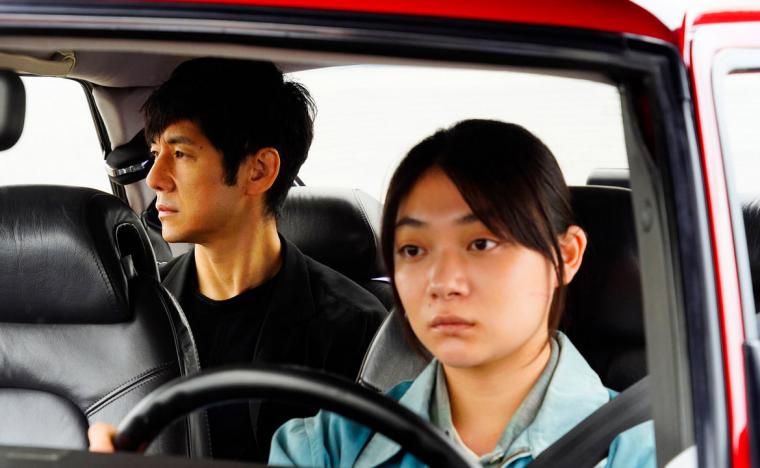
DRIVE MY CAR
Until a couple of weekends ago, only five movies over the decades had received the critics-award trifecta of Best Picture wins from the National Society of Film Critics, Los Angeles Film Critics Association, and New York Film Critics Circle: GoodFellas, Schindler's List, L.A. Confidential, The Hurt Locker, and The Social Network. On January 8, a sixth joined their ranks: Drive My Car, writer/director Ryusuke Hamagachi's three-hour, deeply meditative Japanese drama with dialogue also delivered in English, Mandarin, Indonesian, German, Maylaysian, Korean, and Korean Sign Language. Hamagachi's offering, which also won three prizes (including one for its script co-written by Takamasa Oe) at last year's Cannes Film Festival, just opened at Iowa City's FilmScene at the Chauncey. And if you're wondering whether Drive My Car is truly on par with those five undeniable American classics that preceded its historic sweep – or, conversely, if those critics were just feeling extra-snooty this year – please know that, even after only one viewing, I think it's absolutely the marvel its acknowledgment suggests. I'd make a lame joke about how, for Quad Cities audiences, the film is “worth a Drive!” to Iowa City, but such a stupid crack feels insufficient. It's more accurately worth a flight.
Be aware in advance, though, that Hamagachi's subtle knockout isn't necessarily an “accessible” foreign-language title in the vein of Parasite or Roma or Another Round, even though it'll likely join their ranks as an Oscar recipient for Best International Feature Film. As that running length perhaps implies, the movie requires some patience, and a willingness to dive into complex emotional states, and maybe at least passing acquaintance with Anton Chekhov's Uncle Vanya. (We hear, and see, so many passages from that legendary stage work here that it wouldn't be out of line for Chekhov to also be credited as a co-screenwriter.) But as everyone is acquainted with love, and grief, and the effects of an awfully good story beautifully told, it's hard to imagine who could fail to be moved by this supreme achievement that plays like naturalism yet has the cinematic audacity to feature a five-minute monologue performed straight to the camera and a jump cut to two years in the future and opening credits that arrive 40 minutes into the picture. Over the course of Drive My Car, I'm not sure that a second passed in which I wasn't utterly riveted. I'm frankly surprised I remembered to blink.
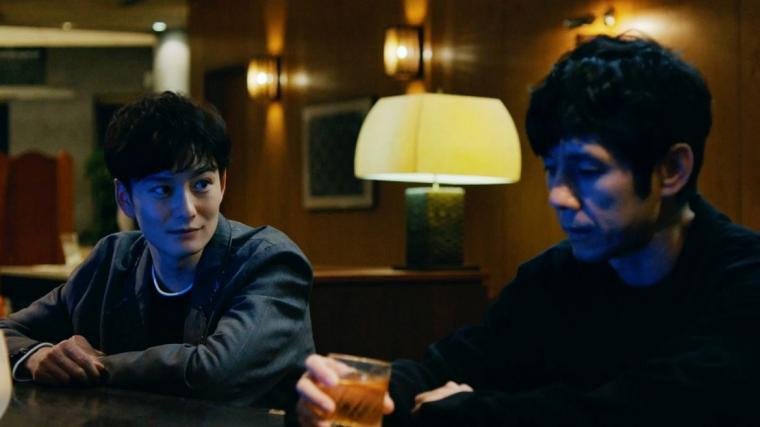
Without giving too much away, considering how skillfully new levels of narrative understanding and character appreciation are woven into the film's design, Hamaguchi's exploration on art affecting life – and vice versa – finds noted theatre actor and director Yūsuke Kafutu (a tremendous Hidetoshi Nishijima) commissioned to stage a multi-lingual production of Uncle Vanya in Hiroshima. He subsequently discovers the play's themes, plot points, and conversations mirrored in his real-life experiences with his wife Oto (Reika Kirishima), her young lover Kōji (Masaki Okada) whom Yūsuke perversely casts as the 47-year-old Vanya, and his assigned driver Masaki (Tōku Miura) who becomes a de facto priest in the rolling confessional of Yūsuke's cherry-red Saab. For theatre geeks like me, this thing is heaven, boasting precisely detailed renderings of the banalities and triumphs in rehearsal rooms and the genius of casting Vanya's Sonia with a mute actor who speaks only in sign. (If Sonia's climactic speech generally reduces you to tears, just wait until you “hear” it with no words vocalized at all.) Yet you gradually realize that Hamaguchi is up to something that's ultimately far more substantive than “merely” an expansive view of an artist wrestling with Chekhov's epic dramatic comedy.
Perceptions are everything in Drive My Car – at least initially. We presume that Oto is a monster for cheating on her husband; that Kōji is an asshole for auditioning for her husband's play; that Yūsuke is a stick-in-the-mud, and maybe a little sexist, for scoffing at the notion of Tōko driving him around. But with superior tact and (sorry) drive, Hamaguchi and Oe incrementally upend all of our early assumptions, releasing important information with devastating economy and surprise, and making us remember – if such reminders are necessary – that no one truly knows anyone, at least not to the extent that we sometimes want and need to. We're constantly unbalanced by the revelations here, but instead of landing with shock, they arrive with soul-cleansing curiosity and empathy – the realization that in the end, as Chekhov's text explicitly states, all we can ever know for certain is what's in our own hearts, and it's up to God to sort out the rest.
Even in the tragicomedy of the Uncle Vanya dialogue, there's nothing inherently melodramatic about Drive My Car. I still found myself quietly weeping at regular intervals. And amidst all the thunderously fine acting and writing – as well as the most potent recognition of the pandemic era that I've yet seen in a movie – Hamaguchi pulls off a minor miracle in the staggering life-force presence of that lovingly cared-for Saab, whose fate I'm both ashamed and unembarrassed to say I cared about nearly as much as Yūsuke's. We do fall in love with our cars. With apologies to all the personal vehicles I've adored over the decades, I think Yūsuke's might be my favorite.
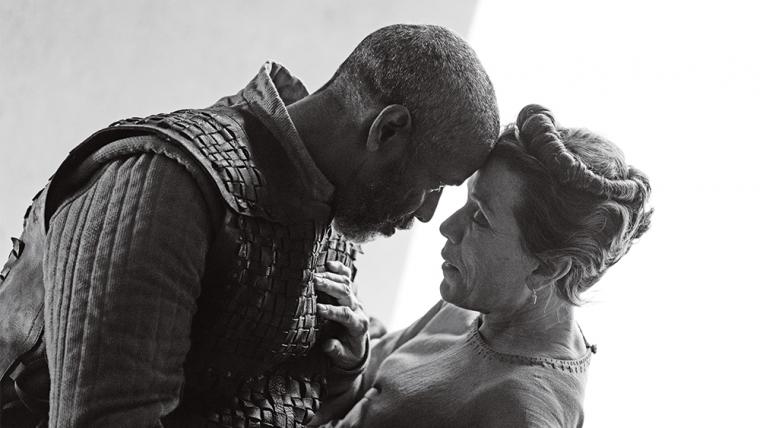
THE TRAGEDY OF MACBETH
In addition to Drive My Car and several other releases, Iowa City's FilmScene – albeit the venue located on the Ped Mall as opposed to at the Chauncey – is currently housing writer/director Joel Coen's adaptation of The Tragedy of Macbeth. That means that a four-block jaunt down College Avenue is all that's now separating patrons from movies inspired by Chekhov and Shakespeare. (Be still, my theatre-major heart!) Being a notorious cheapskate, however, I opted to catch Coen's first cinematic foray without brother Ethan's participation during its weekend debut on Apple+, doing my best to simulate the film's black-and-white environment in a completely darkened living room with snow-covered bushes outside my windows. So given how much I admire Coen, and stars Denzel Washington and Frances McDormand, and Bruno Delbonnel's striking German-expressionist cinematography, and the text itself (it's my all-time-favorite among Bard tragedies), was it simply the absence of a big-screen experience that left me feeling that the film itself was just … fine?
I don't know, and now might never know, but I don't think so. Goodness knows there's greatness on display in The Tragedy of Macbeth's thrillingly vicious tale of royal power grabs, soul-sucking madness, and enough killings for a sixth Scream entry, and not all of them are due to Shakespeare's unimprovable gifts. Those Delbonnel images are absolutely stunning, their geometric precision and alienating emptiness suggesting temperamental fissures – even between perceived allies – that are otherwise merely implied in Shakespeare's language. Coen has clearly dedicated a lot of time and imagination to the visualization of some of the material's most well-remembered moments, refashioning Banquo's ghost as a minor murder of crows and making Macbeth's perceived dagger (the one He Sees Before Him) part of a doorway's architecture. And Kathryn Hunter, who portrays all three weird sisters, performs unfathomable feats with her vocal inflections, also contorting her body in ways that would secure her immediate employment in Cirque du Soleil if there were ever a call for an act that freaked the ever-lovin' bejeezus out of us.
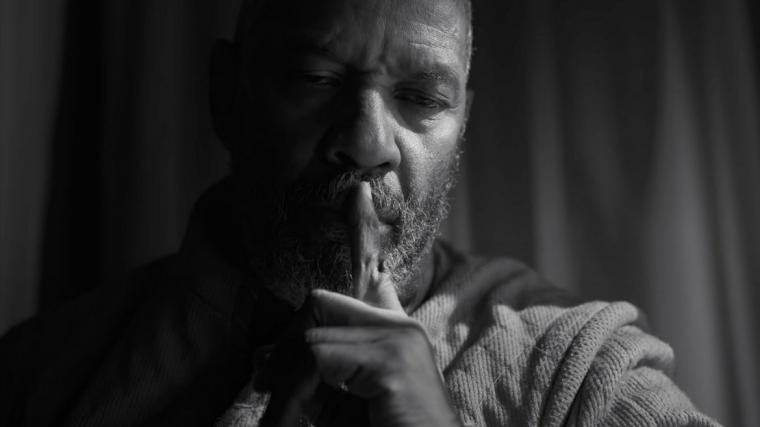
But incredibly, and unfortunately, Hunter and the one-scene wonder Stephen Root (who plays this tragedy's comic-relief porter) are where my performance accolades stop. Because while there are a number of top-tier talents among Coen's cast – Brendan Gleeson, Bertie Carvel, Corey Hawkins, Harry Melling, Moses Ingram, Ralph Ineson, Jefferson Mays – no one appears to have been directed to act the material with the weight their pronouncements deserve; their mostly dull, unaffected readings too easily slip into the film's color-free environment. And even though Washington and McDormand are decades older than their characters as written, I presumed that some point would be made of the age disparity, and that it might illuminate the text in meaningful and original ways. Alas, it doesn't. (This was perhaps wishful thinking on my part: Washington, on Broadway, played A Raisin in the Sun's Walter Lee Younger – a man in his mid-30s – when the actor was approaching 60.)
There's fierceness and fire in Washington's more tormented readings, but whether he's plotting a royal coup or encountering the weird sisters for the first time, we get little but blasé recognition in his expressions; Washington's Macbeth seems to be in month five of an unremarkable six-month stage run. McDormand, meanwhile, gives us exactly the Lady M we expect from her – stoic, uncompromising, unsmiling – with almost nothing in the way of variety, and she and Washington exude no discernible chemistry even when they should be making a nasty meal out of their characters' machinations. Both actors, of course, are traditionally wonderful, singular screen presences, but for each of them, there's an accent on that “singular.” Neither seems entirely comfortable about sharing the screen with others (least of all those cast as significant others), and that greatly damages the overall effectiveness. Running 105 minutes, this Shakespeare is agreeably brisk, impressively shot, and hardly a blight on its source material. It's fine. But in perhaps a first for my personal acquaintance with this much-cherished saga, I didn't feel anything – aside from respect for its designers – while watching it. The Tragedy of Macbeth suggests, hopefully incorrectly, that if Joel is the brain behind the Coen-brothers outfit, the currently absent Ethan may be the heart.
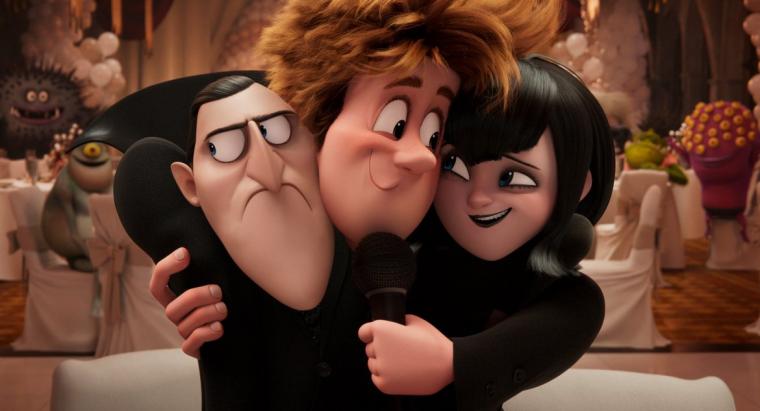
HOTEL TRANSYLVANIA: TRANSFORMANIA
Watching the third sequel Hotel Transylvania: Transformania (newly streaming on Prime Video), you have to ask: Just how far does an animated-comedy franchise have to sink to make even Adam Sandler and Kevin James refuse to accept a fourth guaranteed paycheck? Not that most viewers will notice, but Sandler's role as blah-blah-blah-ing Count Dracula has been filled here by vocal impersonator Brian Hull, and James' Frankenstein by Brad Abrell; the comedy stars' lack of participation, to me, was really only apparent in the closing credits when returning troopers Selena Gomez and Andy Samberg received top billing amongst the cast. Sandler's and James' “unavailability,” however, made sense while watching this featherweight, instantly forgettable trifle involving humans-as-monsters and monsters-as-humans that I only viewed because the weather made an earlier trek to Iowa City unfeasible. There couldn't possibly be any other excuse for viewing it, right?
In fairness, despite the aural participation of personal comedy killers Sandler and James, I didn't hate any of the previous Hotel Transylvanias, and didn't hate this one, either. Directors Derek Drymon and Jennifer Kluska and their trio of screenwriters may not contribute anything fresh to this profoundly silly nonsense, but nothing in this series was fresh to begin with, and I'm always happy to see Kathryn Hahn, Steve Buscemi, Keegan-Michael Key, and Molly Shannon employed. (I'm also happy whenever David Spade is employed in one of these things, if only because that means – due to the animation and his role as the Invisible Man – I don't literally have to see him.) That being said, it would've been nice if just one visual or verbal gag here made me involuntarily giggle out of surprise or delight, and even the whiplash edits and über-goofy body contortions don't have the zing they once did – the whole enterprise feels like something not quite good enough for Kevin James. Not to give away the finale for the spoiler-averse among you, but Hotel Transylvania: Transformania ends with the titular venue's destruction and immediate resurrection, one implying that this property's brightest future may lie in Saturday mornings on broadcast TV. By all means, bring that shift on. Then reviewing it will be someone else's job.










